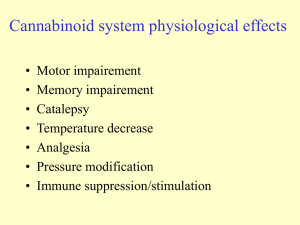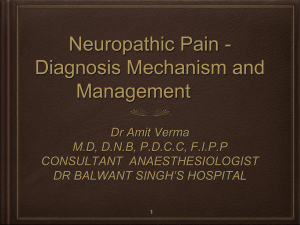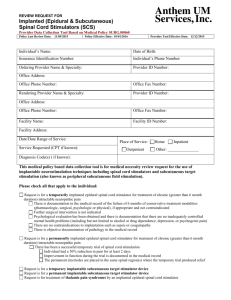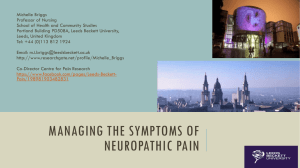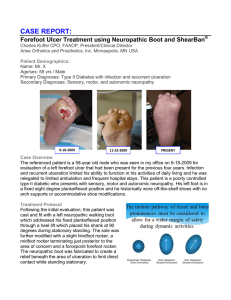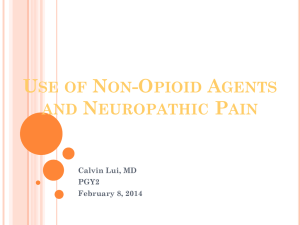Central Neuropathic Pain
advertisement
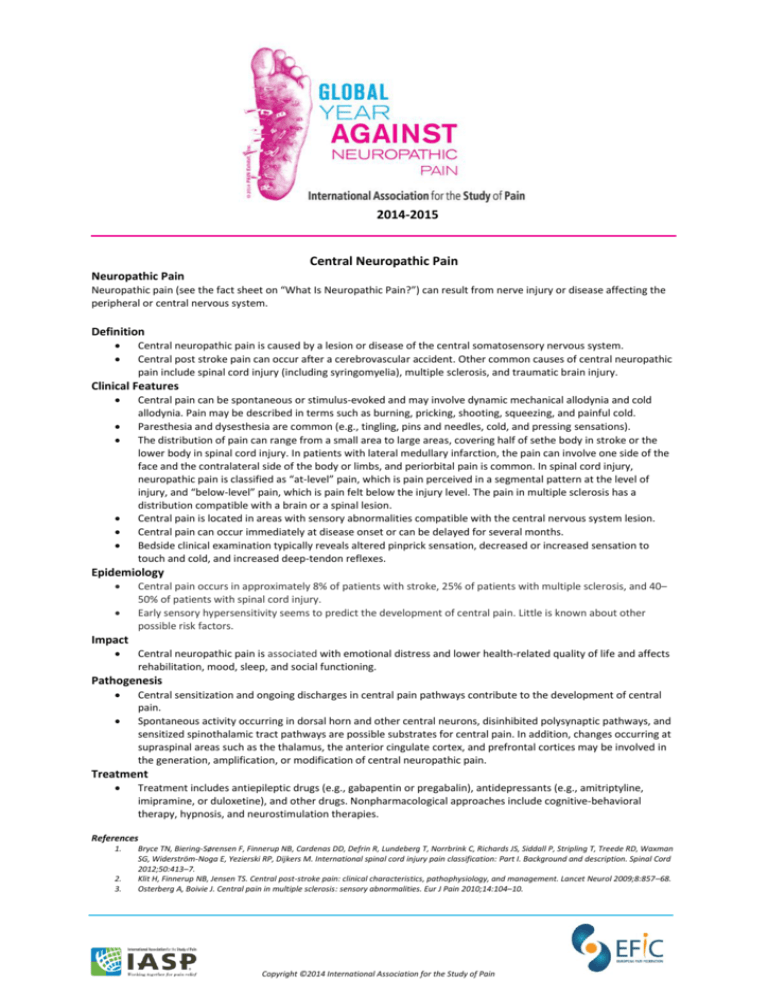
2014-2015 Central Neuropathic Pain Neuropathic Pain Neuropathic pain (see the fact sheet on “What Is Neuropathic Pain?”) can result from nerve injury or disease affecting the peripheral or central nervous system. Definition Central neuropathic pain is caused by a lesion or disease of the central somatosensory nervous system. Central post stroke pain can occur after a cerebrovascular accident. Other common causes of central neuropathic pain include spinal cord injury (including syringomyelia), multiple sclerosis, and traumatic brain injury. Clinical Features Central pain can be spontaneous or stimulus-evoked and may involve dynamic mechanical allodynia and cold allodynia. Pain may be described in terms such as burning, pricking, shooting, squeezing, and painful cold. Paresthesia and dysesthesia are common (e.g., tingling, pins and needles, cold, and pressing sensations). The distribution of pain can range from a small area to large areas, covering half of sethe body in stroke or the lower body in spinal cord injury. In patients with lateral medullary infarction, the pain can involve one side of the face and the contralateral side of the body or limbs, and periorbital pain is common. In spinal cord injury, neuropathic pain is classified as “at-level” pain, which is pain perceived in a segmental pattern at the level of injury, and “below-level” pain, which is pain felt below the injury level. The pain in multiple sclerosis has a distribution compatible with a brain or a spinal lesion. Central pain is located in areas with sensory abnormalities compatible with the central nervous system lesion. Central pain can occur immediately at disease onset or can be delayed for several months. Bedside clinical examination typically reveals altered pinprick sensation, decreased or increased sensation to touch and cold, and increased deep-tendon reflexes. Epidemiology Central pain occurs in approximately 8% of patients with stroke, 25% of patients with multiple sclerosis, and 40– 50% of patients with spinal cord injury. Early sensory hypersensitivity seems to predict the development of central pain. Little is known about other possible risk factors. Impact Central neuropathic pain is associated with emotional distress and lower health-related quality of life and affects rehabilitation, mood, sleep, and social functioning. Pathogenesis Central sensitization and ongoing discharges in central pain pathways contribute to the development of central pain. Spontaneous activity occurring in dorsal horn and other central neurons, disinhibited polysynaptic pathways, and sensitized spinothalamic tract pathways are possible substrates for central pain. In addition, changes occurring at supraspinal areas such as the thalamus, the anterior cingulate cortex, and prefrontal cortices may be involved in the generation, amplification, or modification of central neuropathic pain. Treatment Treatment includes antiepileptic drugs (e.g., gabapentin or pregabalin), antidepressants (e.g., amitriptyline, imipramine, or duloxetine), and other drugs. Nonpharmacological approaches include cognitive-behavioral therapy, hypnosis, and neurostimulation therapies. References 1. 2. 3. Bryce TN, Biering-Sørensen F, Finnerup NB, Cardenas DD, Defrin R, Lundeberg T, Norrbrink C, Richards JS, Siddall P, Stripling T, Treede RD, Waxman SG, Widerström-Noga E, Yezierski RP, Dijkers M. International spinal cord injury pain classification: Part I. Background and description. Spinal Cord 2012;50:413–7. Klit H, Finnerup NB, Jensen TS. Central post-stroke pain: clinical characteristics, pathophysiology, and management. Lancet Neurol 2009;8:857–68. Osterberg A, Boivie J. Central pain in multiple sclerosis: sensory abnormalities. Eur J Pain 2010;14:104–10. Copyright ©2014 International Association for the Study of Pain


